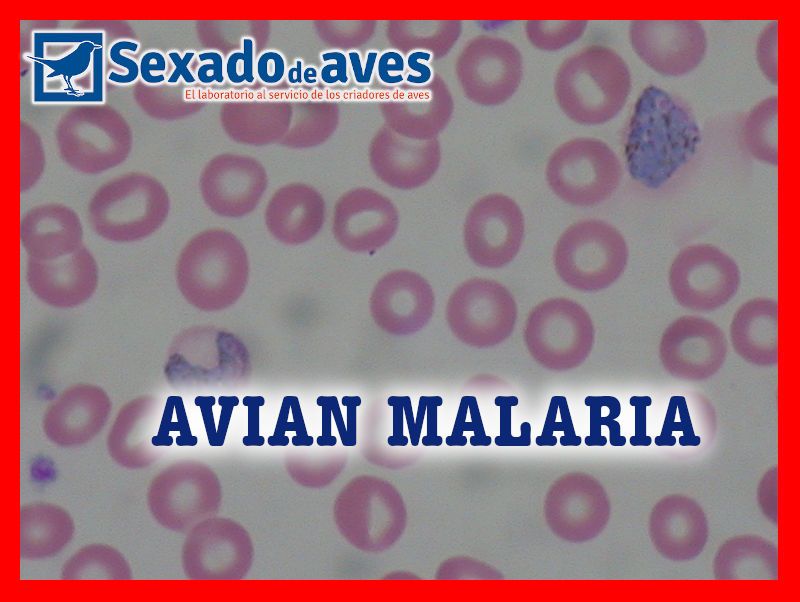Avian Malaria
Malaria is also a matter of bird Malaria is a disease caused by a protozoan parasite that is transmitted by the bite of an infected mosquito, it affects more than 500 million people each year, so

Malaria is also a matter of bird
Malaria is a disease caused by a protozoan parasite that is transmitted by the bite of an infected mosquito, it affects more than 500 million people each year, so this disease is a serious health problem worldwide which affects the most disadvantaged areas of the planet to a greater extent.
However, if I told you that birds, common sparrows, goldfinches, greenfinches or airplanes could also suffer from malaria. Would you believe it?
What is avian malaria?
Like humans, wild and domestic birds can be infected with malaria parasites. There are two main genera of parasites of avian malaria, Plasmodium, and Haemoproteus. Both have very similar life cycles, and the main difference is that mosquitoes and Haemoproteus transmit gnats and flat flies transmit Plasmodium.
Although these parasites are evolutionarily related to the parasites of human malaria, they are related to birds exclusively and do not affect people. One of the main differences between the parasites of human and avian malaria has to do with the parasites of human malaria are transmitted through the mosquito Anopheles. The parasites of avian malaria usually use other species as vectors, being transmitted mainly by the Culex mosquito bite, the Cx species. Its main vector is Pipiens or common mosquito.
The parasites of avian malaria have a complex life cycle divided into two phases, a sexual phase, which takes place within the mosquito, and an asexual phase that takes place inside the birds.
How does malaria affect birds?
If a bird is bitten by a mosquito infected by one of these blood parasites, the parasites (called sporozoites at that stage of their cycle) circulate in the bloodstream. Then, they reach internal organs such as the lung, spleen or liver where they complete part of their life cycle, as well as inside the bird’s red blood cells.
Numerous scientific studies have studied the effects of these parasites on the birds they infect (see links). The affected birds with a high burden of parasites can present fever, diarrhea and suffer from anemia because of the destruction of red blood cells (the cells that cause that color, so characteristic of the blood and are responsible for transporting oxygen throughout the body).
The anemia will be evidenced by depigmentation of the color of the eye and pallor of the mucous membranes of the oral cavity. Besides, anemia causes a lack of appetite and progressive weakening of the individual, affecting its ability to reproduce and may eventually lead to death directly or indirectly, increasing their susceptibility to being preyed upon.
It has also been observed that malaria parasites can affect internal organs causing an increase in size and change in the color of the spleen and liver, and may even form cysts in the latter.
These symptoms can have different degrees of intensity because it depends on the pathogenicity of the parasite and the health status of the host. Young birds usually have a higher degree of mortality.
Even so, not all bird species are equally affected by avian malaria parasites. Birds such as Columbiformes (pigeons and doves) or passerines (sparrows and greenfinches) usually have a higher percentage of infection than Psittaciformes birds (Parrots and Cockatoos).
How can avian malaria be diagnosed in birds?
Avian malaria does not present any visible symptom that allows its clinical diagnosis. To diagnose an infected bird by avian malaria parasites is necessary to extract a blood sample from the individual. The diagnosis can be made through two main methods:
• By performing a blood smear with a drop of blood from the infected animal, after its fixation and staining using specific protocols, it allows the visualization of the parasites through the microscope.
This test allows us to observe those red blood cells that are infected by parasites of avian malaria and depending on the morphological characteristics of the parasite; we can identify the level of the parasite.
Besides, this technique allows quantifying the level of infection of the bird, by counting red blood cells infected with parasites related to the total.
• By using molecular techniques from a few drops of blood, after that, the extraction of the genetic material from the parasite, amplification techniques are carried out on specific areas of the genetic material of the parasite that makes possible to identify accurately the blood parasite species or genetic lineage that It is infecting the bird.
Unlike the previous method, the realization of molecular techniques is even more accurate and allows the identification of parasites at levels that are undetectable by performing blood smears.
Undoubtedly, both methods allow the identification of the infection status of the individual and, at any case one test is exclusive of the other one. It is recommended to carry out both tests since they provide complementary information.
Does avian malaria have any treatment?
Avian malaria is a chronic disease, so it is challenging for the parasites to disappear entirely from the animal’s body. The infection by parasites of avian malaria is characterized by two phases, an initial one which birds have a high parasite load in its blood, followed by a chronic phase which individuals present a decrease in the number of parasites in their blood.
During the last phase cysts of resistance can be formed in the liver of intermediate phases of the parasites. In the time of stress for the bird, like the breeding season, there can be a rise of new stages with a high parasite load in their blood (a simile would be the annoying cold sores).
Some treatments such as primaquine (a prophylactic) or chloroquine, may help to decrease the parasite load on the blood organs. Although these treatments are reliable and they can affect the bird significantly with respiratory problems and gastric disorders.
An extra contribution of liquids and food supplements also help the infected birds.
How can the spread of avian malaria be prevented?
There is not a 100%-effective-method can prevent the spread of avian malaria. Besides, the conditions of temperature and humidity in Andalucia turn this city into a very propitious area so that the main insects may transmit avian malaria and reproduce (mosquitoes, gnats and flat flies)
This fact makes Andalusia an area with a high prevalence of avian malaria. Undoubtedly, the best methods to prevent infection have to focus on preventing these insects from biting our birds.
Therefore, it is better to keep domestic birds in appropriate conditions, being treated with insecticides regularly and keeping them in mosquito-free spaces by using mosquito nets.
Finally, it is essential to check the nests carefully, because they are very favorable areas for the hiding and rest of the mosquitoes, on those that are closed. Finally, it is also highly recommended to place products against mosquitoes.
Dr. Rafael Gutiérrez López
Matta, N. E., & Rodríguez, O. A. (2001). Hemoparásitos aviares Avian Haematoza. Acta Biológica Colombiana, 6(1), 27-34.
https://revistas.unal.edu.co/index.php/actabiol/article/view/63464/pdf
Atkinson, C. T., Dusek, R. J., Woods, K. L., & Iko, W. M. (2000). Pathogenicity of avian malaria in experimentally-infected Hawaii Amakihi. Journal of wildlife diseases, 36(2), 197-201.
https://www.jwildlifedis.org/doi/pdf/10.7589/0090-3558-36.2.197
